Special Report
State Economies Most Likely to Be Crippled by COVID-19

Published:
Last Updated:

To slow the spread of the novel coronavirus and save lives, millions of Americans nationwide have been urged or ordered by their state or local government to stay at home. In addition to stay-at-home orders, many of which have now been in effect for at least a month, many states have also ordered the closure of nonessential businesses. The economic effects of these measures have begun to take a devastating toll. Close to 30 million Americans have filed for unemployment benefits since mid-March.
While every American will feel the effects of the economic downturn to some degree, certain industries seem to be especially vulnerable. According to analysis by Moody’s Analytics, an economics research firm, these industries include leisure and hospitality, travel services, transportation and warehousing, and oil and gas extraction. Here is an in-depth look at the U.S. industries being devastated by the coronavirus.
While not addressing the public health concern and fighting the pandemic could have come at a steep economic cost, the measures taken to fight the spread of the coronavirus have also come at a steep cost as much of the economy has effectively ground to a halt. In some states, more than 20% of the labor force has filed for unemployment, with million more layoffs announced each week.
24/7 Wall St. created an index of the pandemic’s ongoing impact on each state’s economy, taking into account the number of COVID-19 cases per 10,000 residents, the share of employment in industries deemed high risk by Moody’s, new unemployment claims since mid-March and projected unemployment rates by state for July 2020 from the Economic Policy Institute, a nonpartisan, nonprofit think tank.
Even as case numbers continue to rise in every state, stay-at-home orders set to expire in the coming week in some states, while others have explicitly announced plans to reopen parts of the economy in the near future. It is unclear how much of an impact reopening states will have on revitalizing local economies. For example, the decimation of global energy prices currently threatening independent oil and gas businesses will continue to impact those businesses even as states reopen.
Click here to see the state economies most likely to be hurt by COVID
Click here to read our methodology

50. South Dakota
> Workforce in high-risk industries: 14.5% of total (2nd lowest)
> Unemployment claims since mid-March: 28,187 (6.2% of workforce — the lowest)
> COVID cases as of April 27, 2020: 2,040 (23.1 per 10,000 people — 14th highest)
> COVID deaths as of April 27, 2020: 10 (0.1 per 10,000 people — 2nd lowest)
> Projected unemployment rate, July 2020: 15.8% (15th highest)
South Dakota’s economy is less exposed than the economies of other states to the effects of the pandemic and resulting economic fallout largely because of its employment composition. Only 14.5% of workers in South Dakota are employed in industries that are at high risk of slowdown due to efforts to contain the virus. Since mid-March, only 28,187 workers in the state, or 6.2% of the total labor force, have claimed unemployment — the smallest share among states.
[in-text-ad]
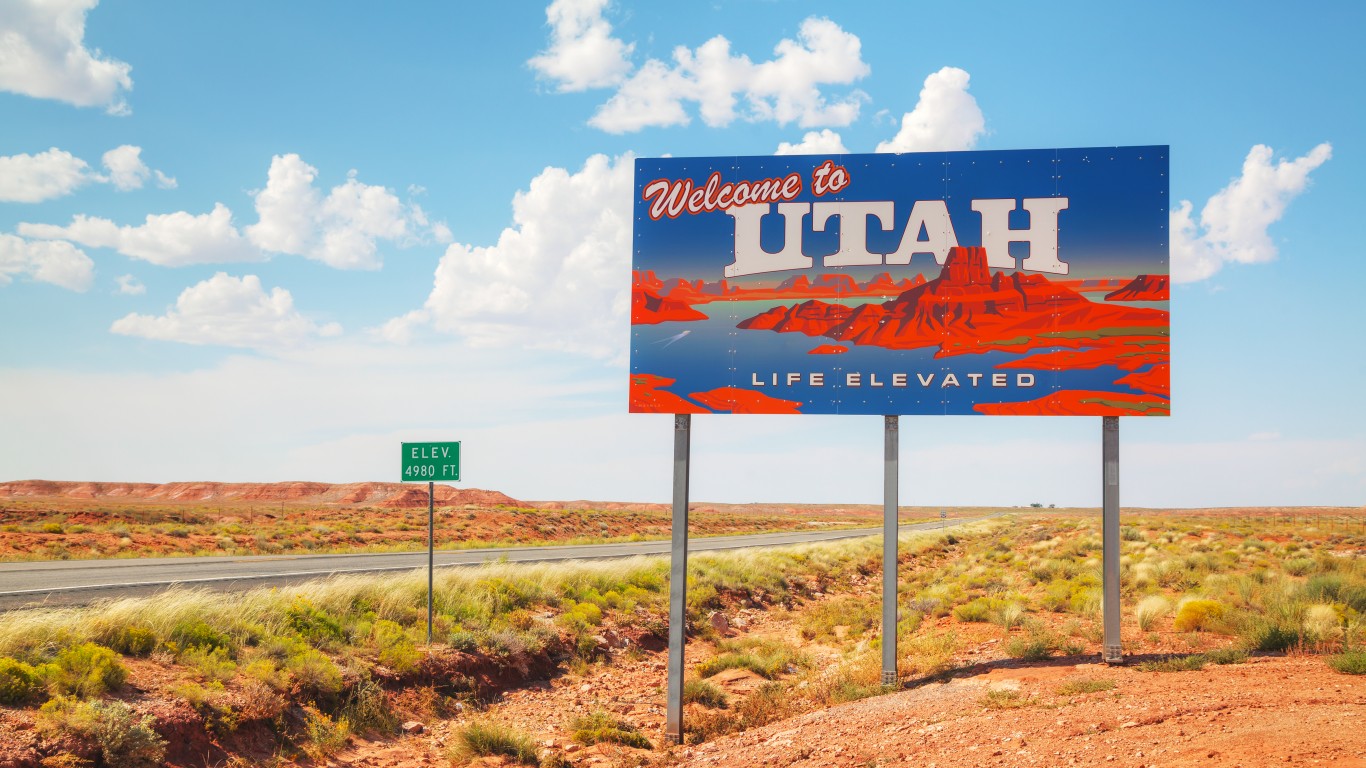
49. Utah
> Workforce in high-risk industries: 17.0% of total (25th lowest)
> Unemployment claims since mid-March: 125,050 (7.9% of workforce — 2nd lowest)
> COVID cases as of April 27, 2020: 4,123 (13.0 per 10,000 people — 23rd lowest)
> COVID deaths as of April 27, 2020: 41 (0.1 per 10,000 people — 5th lowest)
> Projected unemployment rate, July 2020: 14.8% (10th lowest)
Utah ranks as the state at the second lowest level of risk of economic damage due to COVID-19. The state is one of the few that did not issue a statewide stay-at-home order or closure of nonessential businesses, although some municipalities, including Salt Lake County, have issued their own stay-at-home orders. About 125,000 people in the state have filed for unemployment since mid-march, amounting to less than 8% of the labor force — the second smallest share of any state.
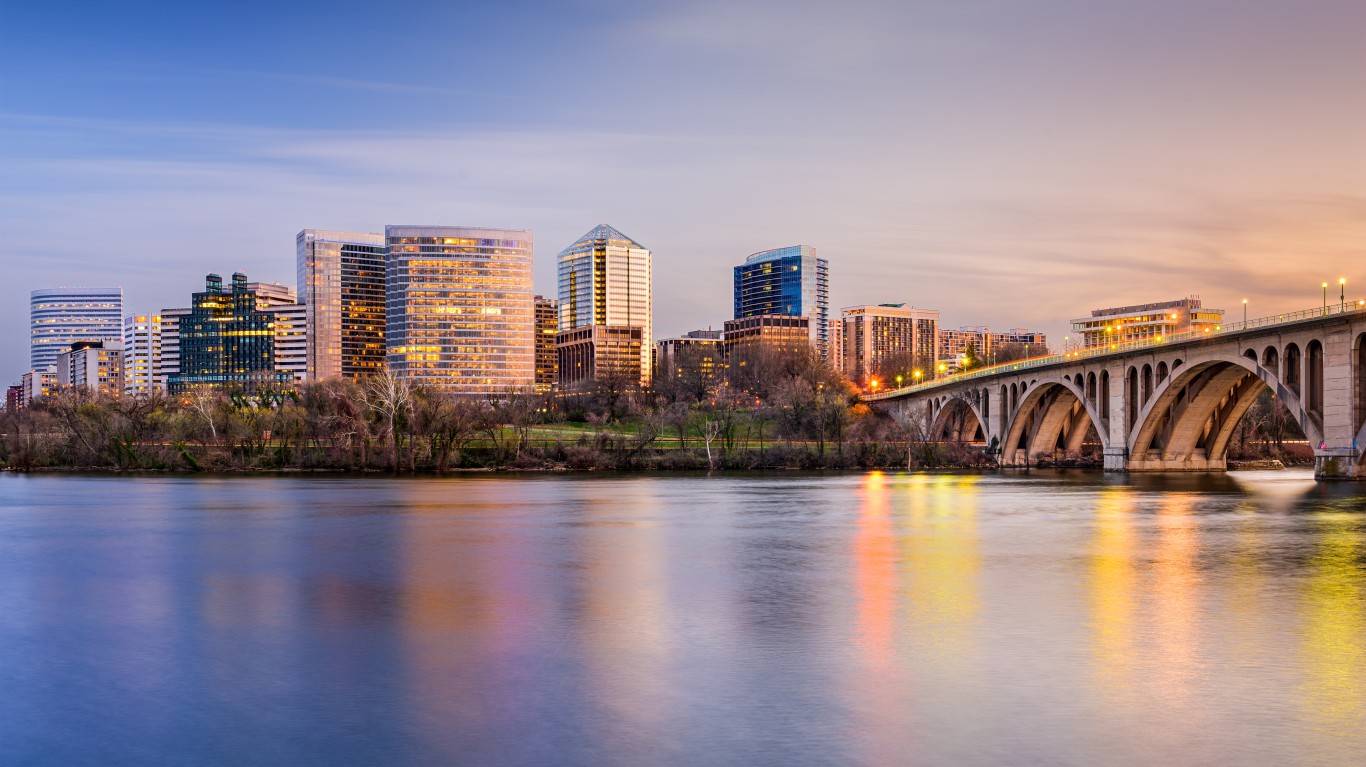
48. Virginia
> Workforce in high-risk industries: 15.7% of total (13th lowest)
> Unemployment claims since mid-March: 495,149 (11.3% of workforce — 11th lowest)
> COVID cases as of April 27, 2020: 12,970 (15.2 per 10,000 people — 21st highest)
> COVID deaths as of April 27, 2020: 448 (0.5 per 10,000 people — 20th highest)
> Projected unemployment rate, July 2020: 14.0% (3rd lowest)
Densely-populated states are more likely to have more COVID-19 cases per capita. In Virginia, despite the greater than average population density, the 15.2 confirmed COVID-19 cases per 10,000 people is lower than the national figure of 29.4 per 10,000. Additionally, a relatively small share of workers in the state are employed in industries that are particularly vulnerable to slowdown in the wake of the measures taken to slow down the spread of the virus.
Due to the relatively low number of infections and favorable employment composition, Virginia’s economy will not likely be hit as hard as many other parts of the country by the coronavirus.

47. Maryland
> Workforce in high-risk industries: 15.7% of total (12th lowest)
> Unemployment claims since mid-March: 347,367 (10.7% of workforce — 7th lowest)
> COVID cases as of April 27, 2020: 16,616 (27.5 per 10,000 people — 11th highest)
> COVID deaths as of April 27, 2020: 723 (1.2 per 10,000 people — 12th highest)
> Projected unemployment rate, July 2020: 13.9% (the lowest)
As is the case with its neighbor to the south, Virginia, Maryland’s economy is not especially exposed to slowdown in the wake of COVID-19. A relatively small share of workers in the state, 15.7%, are employed in industries that are projected to bear the brunt of the economic fallout. According to estimates by the Economic Policy Institute, Maryland’s unemployment rate in July will be just 13.9%, the lowest of any state according to projections.
[in-text-ad-2]

46. Nebraska
> Workforce in high-risk industries: 15.7% of total (11th lowest)
> Unemployment claims since mid-March: 96,098 (9.4% of workforce — 5th lowest)
> COVID cases as of April 27, 2020: 3,028 (15.7 per 10,000 people — 19th highest)
> COVID deaths as of April 27, 2020: 56 (0.3 per 10,000 people — 13th lowest)
> Projected unemployment rate, July 2020: 15.1% (18th lowest)
Nebraska is one of the six states where less than 10% of the labor force has applied for unemployment since the first massive wave of national unemployment claims hit in mid-March. The structure of the state’s economy has made Nebraska somewhat less vulnerable to the effects of the pandemic and the measures taken to combat it. The state has relatively low employment in particularly hard-hit industries such as leisure and hospitality and mining. To date, Nebraska is one the few states not to issue statewide stay-at-home order or a closure of nonessential businesses.

45. Idaho
> Workforce in high-risk industries: 16.1% of total (16th lowest)
> Unemployment claims since mid-March: 108,418 (12.5% of workforce — 19th lowest)
> COVID cases as of April 27, 2020: 1,897 (10.8 per 10,000 people — 17th lowest)
> COVID deaths as of April 27, 2020: 56 (0.3 per 10,000 people — 15th lowest)
> Projected unemployment rate, July 2020: 14.0% (3rd lowest)
Idaho had fewer than 2,000 reported cases as of COVID-19 as of April 27. Even after adjusting for its relatively low population, Idaho has one of the lower number of diagnosed cases per capita among states. The state has a smaller-than-typical share of employment in industries at high risk from the crisis, and the EPI’s projected unemployment rate by july of 14.0%, while high, would be lower than all but two states.
[in-text-ad]

44. Iowa
> Workforce in high-risk industries: 14.9% of total (3rd lowest)
> Unemployment claims since mid-March: 232,913 (13.6% of workforce — 25th highest)
> COVID cases as of April 27, 2020: 5,868 (18.6 per 10,000 people — 17th highest)
> COVID deaths as of April 27, 2020: 127 (0.4 per 10,000 people — 19th lowest)
> Projected unemployment rate, July 2020: 14.2% (5th lowest)
Iowa is one of only five states where fewer than 15% of workers are employed in industries that are at high risk of slowdown due to COVID-19. Starting on May 1, Iowa will begin lifting business restrictions in 77 of its 99 counties. Starting in May, restaurants, gyms, and retailers in those counties can reopen so long as they operate at 50% of their maximum occupancy.

43. Colorado
> Workforce in high-risk industries: 18.6% of total (19th highest)
> Unemployment claims since mid-March: 301,177 (9.7% of workforce — 6th lowest)
> COVID cases as of April 27, 2020: 13,441 (23.6 per 10,000 people — 13th highest)
> COVID deaths as of April 27, 2020: 680 (1.2 per 10,000 people — 13th highest)
> Projected unemployment rate, July 2020: 14.1% (4th lowest)
Colorado’s unemployment claims since the crisis began, while high, have been relatively low compared to most other states. It is one of just six states where the new weekly unemployment claims have represented less than 10% of the state labor force. The EPI projects that Colorado’s unemployment rate in July will be 14.1%, the fourth lowest of any state according to projections. Colorado currently has a “safer at home” advisory, which means that while residents are not ordered to stay at home, they are advised to do so.

42. Kansas
> Workforce in high-risk industries: 15.8% of total (14th lowest)
> Unemployment claims since mid-March: 188,992 (12.8% of workforce — 21st lowest)
> COVID cases as of April 27, 2020: 3,174 (10.9 per 10,000 people — 18th lowest)
> COVID deaths as of April 27, 2020: 118 (0.4 per 10,000 people — 20th lowest)
> Projected unemployment rate, July 2020: 14.7% (8th lowest)
So far, Kansas has not reported the same level of COVID-19 diagnoses as much of the rest of the country. As of late April, there have been 10.9 confirmed cases per 10,000 people, well below the national 29.4 diagnosed cases per 10,000 people.
The virus will also not likely to take as heavy an economic toll as it will in much of the rest of the country. According to the EPI, Kansas’s projected July unemployment rate will be 14.7%, lower than in the vast majority of states.
[in-text-ad-2]
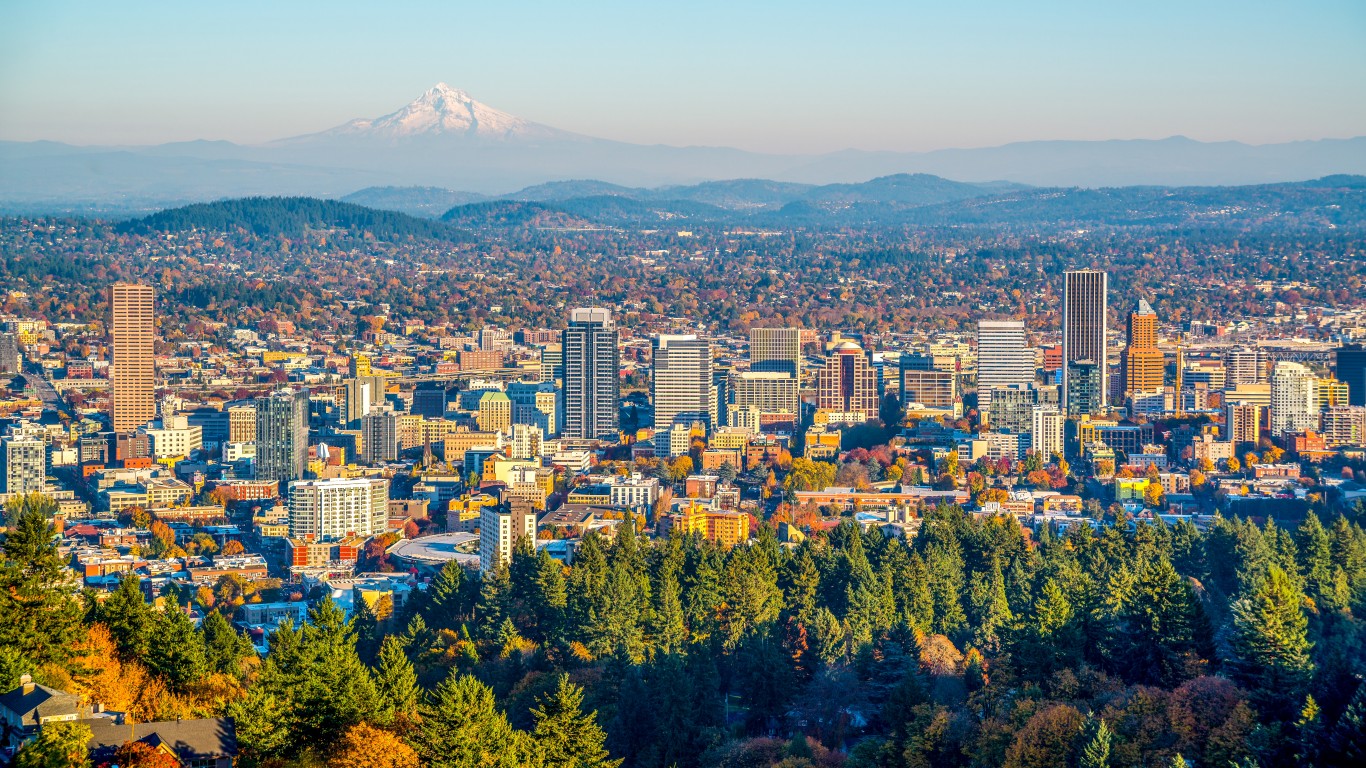
41. Oregon
> Workforce in high-risk industries: 16.4% of total (18th lowest)
> Unemployment claims since mid-March: 230,022 (11.0% of workforce — 8th lowest)
> COVID cases as of April 27, 2020: 2,311 (5.5 per 10,000 people — 4th lowest)
> COVID deaths as of April 27, 2020: 91 (0.2 per 10,000 people — 9th lowest)
> Projected unemployment rate, July 2020: 15.5% (24th highest)
Only 16.4% of workers in Oregon are employed in industries that are at high-risk of slowdown in the wake of the COVID-19 pandemic — a smaller share than in the majority of states.
Oregon has been under a statewide stay-at-home order since March 23 and will coordinate the reopening of its economy with its neighbors along the Pacific Coast, California and Washington.

40. Texas
> Workforce in high-risk industries: 19.6% of total (11th highest)
> Unemployment claims since mid-March: 1.3 million (9.3% of workforce — 4th lowest)
> COVID cases as of April 27, 2020: 25,297 (8.8 per 10,000 people — 11th lowest)
> COVID deaths as of April 27, 2020: 663 (0.2 per 10,000 people — 10th lowest)
> Projected unemployment rate, July 2020: 15.2% (21st lowest)
The oil and gas extraction industry employs far more people in Texas than in most other states — and the industry is more exposed than most to a slowdown in the wake of COVID-19. Still, the Lone Star State economy has been more resilient than most to the economic repercussions of the efforts to contain the virus. So far, just 9.3% of the state’s labor force have filed for unemployment since mid-March, a smaller share than in all but three other states. Texas Gov. Greg Abbott plans to reopen the state on May 1.
[in-text-ad]

39. Arkansas
> Workforce in high-risk industries: 17.0% of total (23rd lowest)
> Unemployment claims since mid-March: 158,982 (11.7% of workforce — 14th lowest)
> COVID cases as of April 27, 2020: 3,001 (10.0 per 10,000 people — 14th lowest)
> COVID deaths as of April 27, 2020: 50 (0.2 per 10,000 people — 7th lowest)
> Projected unemployment rate, July 2020: 15.3% (22nd lowest)
The unemployment rate in Arkansas in March 2020 stood at 4.8% — higher than the 4.4% national rate. However, job losses in the coming months will likely not be as bad in the state as in much of the rest of the country. According to estimates from the EPI, the state’s projected unemployment rate in July will be 15.3%, below the projection of 15.6% for the national unemployment rate.
In Arkansas, workers are less likely to be employed in the industries bearing the economic brunt of the pandemic. Arkansas also has a lower rate of confirmed cases than most other states.

38. Wisconsin
> Workforce in high-risk industries: 15.8% of total (15th lowest)
> Unemployment claims since mid-March: 392,674 (12.7% of workforce — 20th lowest)
> COVID cases as of April 27, 2020: 5,911 (10.2 per 10,000 people — 15th lowest)
> COVID deaths as of April 27, 2020: 272 (0.5 per 10,000 people — 25th highest)
> Projected unemployment rate, July 2020: 15.6% (19th highest)
So far, Wisconsin has not been hit as hard as most other states by the virus. The state’s infection count of about 10 cases per 10,000 residents is well below the national figure of 29.4 per 10,000. The economic toll has also been lighter than average in Wisconsin. Since mid-March, just 12.7% of the labor force have filed for unemployment, a smaller share than in the majority of states.
As is the case in the rest of the country, the situation in Wisconsin remains fluid. A recent study found that over a third of businesses in the state could fail if the shutdown lasts three months. So far, Wisconsin has been shut down for just over one month.

37. Vermont
> Workforce in high-risk industries: 15.4% of total (10th lowest)
> Unemployment claims since mid-March: 50,987 (14.8% of workforce — 20th highest)
> COVID cases as of April 27, 2020: 834 (13.3 per 10,000 people — 25th lowest)
> COVID deaths as of April 27, 2020: 47 (0.8 per 10,000 people — 17th highest)
> Projected unemployment rate, July 2020: 15.0% (16th lowest)
Only 15.4% of workers in Vermont are employed in industries that are highly exposed to an economic slowdown in the wake of COVID-19. Gov. Phil Scott has already begun reopening certain construction and manufacturing businesses as of April 27, with more businesses, including farmer’s markets, slated to reopen on May 1. The state has been under a stay-at-home order since March 25.
[in-text-ad-2]
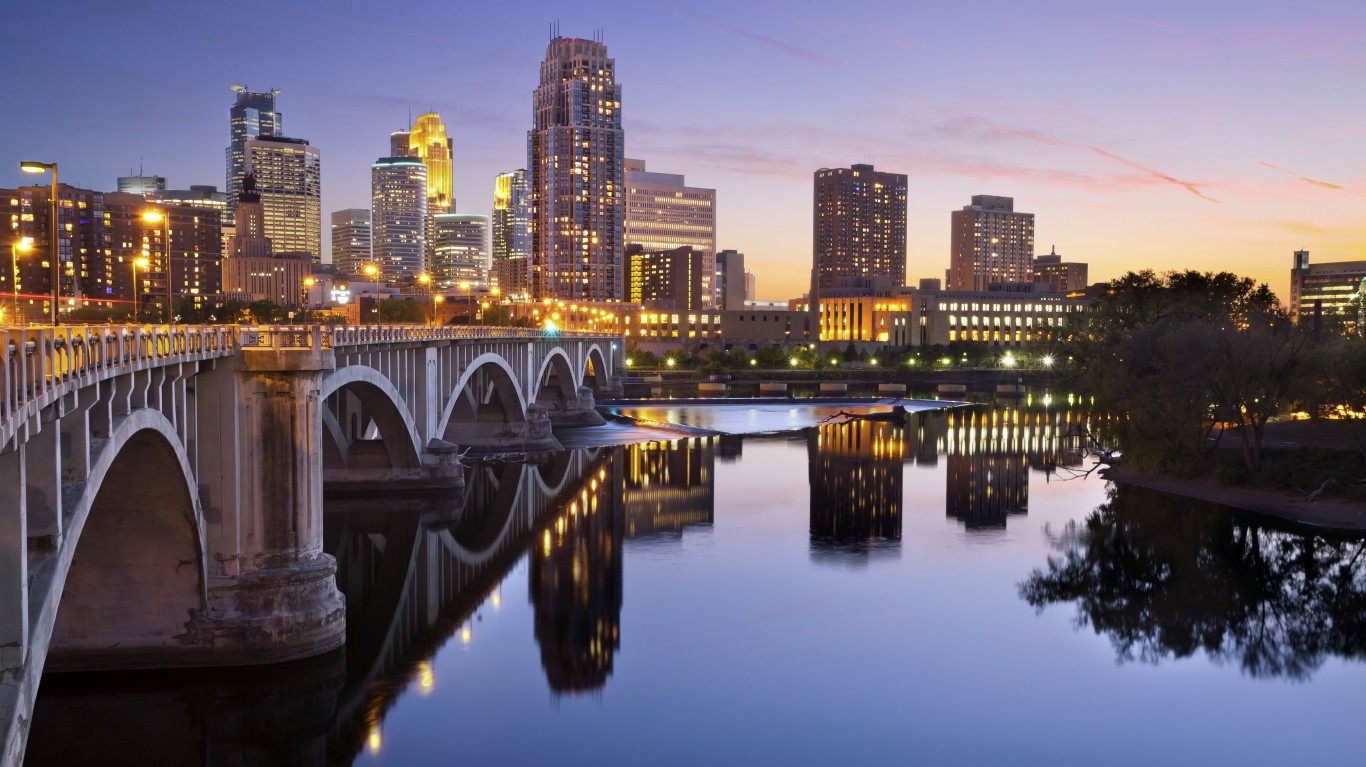
36. Minnesota
> Workforce in high-risk industries: 14.9% of total (4th lowest)
> Unemployment claims since mid-March: 503,134 (16.3% of workforce — 16th highest)
> COVID cases as of April 27, 2020: 3,816 (6.8 per 10,000 people — 7th lowest)
> COVID deaths as of April 27, 2020: 286 (0.5 per 10,000 people — 22nd highest)
> Projected unemployment rate, July 2020: 15.0% (16th lowest)
Minnesota is one of only a handful of states where fewer than 15% of all workers are employed in industries that are expected to bear the brunt of the COVID-19 economic downturn. Partially as a result, the state’s unemployment rate in the coming months is not expected to climb as high as it will likely climb in most other states.
So far, the coronavirus has not infected many people in Minnesota. There have been just 6.8 confirmed infections for every 10,000 state residents as of April 27, lower than in all but six other states.

35. Missouri
> Workforce in high-risk industries: 16.6% of total (19th lowest)
> Unemployment claims since mid-March: 392,799 (12.8% of workforce — 24th lowest)
> COVID cases as of April 27, 2020: 6,997 (11.4 per 10,000 people — 20th lowest)
> COVID deaths as of April 27, 2020: 274 (0.4 per 10,000 people — 23rd lowest)
> Projected unemployment rate, July 2020: 15.7% (17th highest)
Compared to the average nationwide, relatively fewer workers in Missouri are employed in industries most vulnerable to the economic impact of the coronavirus, including mining, transportation, and leisure and hospitality. Of states that issued stay-at-home orders, Missouri was one of the last states to do so. The order took effect on April 6 and remains in effect through at least May 3. Gov. Mike Parson has released a plan to reopen the state on May 4.
[in-text-ad]

34. Alabama
> Workforce in high-risk industries: 16.8% of total (21st lowest)
> Unemployment claims since mid-March: 341,561 (15.2% of workforce — 18th highest)
> COVID cases as of April 27, 2020: 6,467 (13.2 per 10,000 people — 24th lowest)
> COVID deaths as of April 27, 2020: 219 (0.4 per 10,000 people — 24th lowest)
> Projected unemployment rate, July 2020: 14.5% (6th lowest)
A relatively high 37% of Alabama’s employment is in industries that are at moderate risk for the worst economic repercussions of COVID-19 and the social distancing measures taken to contain the spread of virus, including closure of nonessential businesses. The closures include the state’s substantial manufacturing sector, which accounts for 13.6% of state employment, the fifth largest share of any state. Gov. Kay Ivey announced on April 28 plans to partially reopen the state to businesses, with the new “safer at home” policy set to go into effect on April 30.

33. Maine
> Workforce in high-risk industries: 15.1% of total (8th lowest)
> Unemployment claims since mid-March: 101,073 (14.8% of workforce — 21st highest)
> COVID cases as of April 27, 2020: 1,023 (7.6 per 10,000 people — 8th lowest)
> COVID deaths as of April 27, 2020: 51 (0.4 per 10,000 people — 17th lowest)
> Projected unemployment rate, July 2020: 15.7% (17th highest)
A relatively low 15.1% of Maine’s employment is in industries with the highest level of vulnerability to the economic effects of COVID-19, including industries such as mining and transportation and warehousing. While the state has a substantial share of employment in leisure and hospitality, another high-risk industry.
The state has also had one of the lowest infection counts per capita of any state, with just 7.6 cases reported per 10,000 residents as of April 27, nearly one-fourth the national figure of 29.4 cases per 10,000 people.

32. Oklahoma
> Workforce in high-risk industries: 19.9% of total (7th highest)
> Unemployment claims since mid-March: 224,982 (12.3% of workforce — 18th lowest)
> COVID cases as of April 27, 2020: 3,253 (8.2 per 10,000 people — 9th lowest)
> COVID deaths as of April 27, 2020: 195 (0.5 per 10,000 people — 23rd highest)
> Projected unemployment rate, July 2020: 14.7% (8th lowest)
Almost 20% of Oklahoma’s workforce is in a high-risk industry, one of the higher shares of any state. Notably, the state’s substantial oil sector is at risk after the price of crude oil plummeted into negative territory in mid-April and a number of oil and gas operations around the country have announced they could be facing bankruptcy. Gov. Kevin Stitt on April 27 publicly called on President Donald Trump to declare the ongoing COVID-19 crisis an “act of God,” which would protect struggling companies from losing their leases.
[in-text-ad-2]

31. Connecticut
> Workforce in high-risk industries: 14.2% of total (the lowest)
> Unemployment claims since mid-March: 228,598 (12.1% of workforce — 17th lowest)
> COVID cases as of April 27, 2020: 25,269 (70.7 per 10,000 people — 5th highest)
> COVID deaths as of April 27, 2020: 1,924 (5.4 per 10,000 people — 3rd highest)
> Projected unemployment rate, July 2020: 14.8% (10th lowest)
Only 14.2% of workers in Connecticut are employed in industries expected to bear the brunt of the economic downturn brought on by measures taken to contain the pandemic, the smallest share of any state. Partially as a result, Connecticut’s projected July unemployment rate of 14.8% is lower than the projected rate of most other states.
Connecticut is a densely-populated state, and despite having been one of the first states to close nonessential businesses and issue a stay-at-home order, it has one of the highest COVID-19 infection counts per capita. There have been 70.7 confirmed cases for every 10,000 people, more than double the national infection rate of 29.4 per 10,000.

30. North Carolina
> Workforce in high-risk industries: 17.6% of total (23rd highest)
> Unemployment claims since mid-March: 648,320 (12.8% of workforce — 22nd lowest)
> COVID cases as of April 27, 2020: 9,142 (8.8 per 10,000 people — 10th lowest)
> COVID deaths as of April 27, 2020: 306 (0.3 per 10,000 people — 14th lowest)
> Projected unemployment rate, July 2020: 15.5% (24th highest)
The number of diagnosed COVID-19 cases in North Carolina so far has been relatively low, with just 8.8 cases per 10,000 residents as of April 27, less than a third of the national figure of 29.4 per 10,000 people. The state has relatively high employment in certain especially vulnerable industries to the coronavirus crisis, including in services and leisure and hospitality. On April 27, Gov. Roy Cooper announced that the state’s stay-at-home order would continue for at least an additional two weeks.
[in-text-ad]

29. Arizona
> Workforce in high-risk industries: 19.3% of total (15th highest)
> Unemployment claims since mid-March: 421,090 (12.0% of workforce — 16th lowest)
> COVID cases as of April 27, 2020: 6,526 (9.1 per 10,000 people — 12th lowest)
> COVID deaths as of April 27, 2020: 275 (0.4 per 10,000 people — 18th lowest)
> Projected unemployment rate, July 2020: 15.4% (24th lowest)
Arizona’s unemployment rate is projected to be 15.4% by July, roughly in ine with the projected national rate of 15.6%, according to projections from the EPI. Nearly one in every five workers in the state are employed in industries that are expected to slow down the most in wake of the pandemic.
Despite imposing stay-at-home orders later than most states, the number of diagnosed cases relative to the size of the population in Arizona is lower than average. There have been just 9.1 confirmed cases of the virus for every 10,000 Arizona residents, less than one-third of the comparable national infection figure.

28. West Virginia
> Workforce in high-risk industries: 18.2% of total (20th highest)
> Unemployment claims since mid-March: 93,748 (11.9% of workforce — 15th lowest)
> COVID cases as of April 27, 2020: 1,053 (5.8 per 10,000 people — 5th lowest)
> COVID deaths as of April 27, 2020: 34 (0.2 per 10,000 people — 8th lowest)
> Projected unemployment rate, July 2020: 16.3% (10th highest)
As a state whose residents have long struggled economically, West Virginia had one of the highest unemployment rates in the country before this crisis began. The state’s unemployment rate as of March has jumped to 6.1%, third highest of any state. West Virginia has a relatively low share of employment in medium-risk industries and relatively high shares in high-risk industries such as mining and low-risk industries such as health care.

27. New Mexico
> Workforce in high-risk industries: 18.8% of total (18th highest)
> Unemployment claims since mid-March: 104,467 (11.0% of workforce — 9th lowest)
> COVID cases as of April 27, 2020: 2,726 (13.0 per 10,000 people — 22nd lowest)
> COVID deaths as of April 27, 2020: 99 (0.5 per 10,000 people — 24th highest)
> Projected unemployment rate, July 2020: 16.2% (14th highest)
Before the coronavirus pandemic shut New Mexico down, the state had one of the worst job markets in the country, with a 5.9% May unemployment rate. Partially because of the large share of workers in the state employed in oil and gas extraction — an industry more susceptible than most to slowing down in the wake of the virus — the state’s unemployment rate is projected to reach 16.2% by July, higher than what is expected in most other states.
A stay at home order took effect in New Mexico on March 24, and recently, a group of 19 mayors across the state signed a petition that was sent to the governor requesting that nonessential businesses reopen.
[in-text-ad-2]

26. Florida
> Workforce in high-risk industries: 20.1% of total (6th highest)
> Unemployment claims since mid-March: 1.2 million (11.3% of workforce — 10th lowest)
> COVID cases as of April 27, 2020: 32,138 (15.1 per 10,000 people — 22nd highest)
> COVID deaths as of April 27, 2020: 1,088 (0.5 per 10,000 people — 21st highest)
> Projected unemployment rate, July 2020: 15.5% (24th highest)
Florida is one of just six states where over 20% of state employment is concentrated in industries that are most vulnerable to the economic effects of the efforts to contain COVID-19. Notably, leisure and hospitality accounted for 14.1% of state employment in 2018, and travel. Walt Disney World Resorts in Orlando, the largest single-location employer in the country, furloughed over 40,000 workers after it had been closed for more than a month.
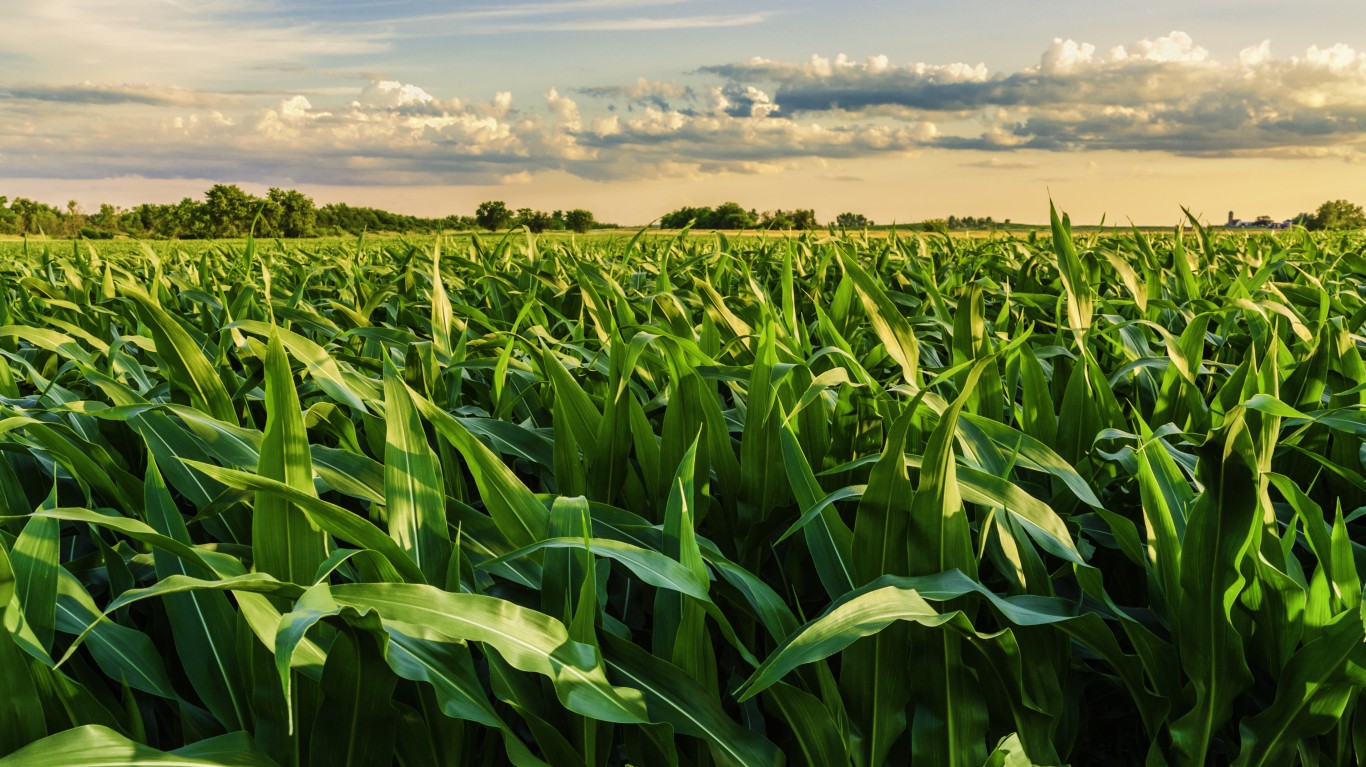
25. Illinois
> Workforce in high-risk industries: 18.8% of total (17th highest)
> Unemployment claims since mid-March: 737,472 (11.4% of workforce — 12th lowest)
> COVID cases as of April 27, 2020: 43,903 (34.5 per 10,000 people — 9th highest)
> COVID deaths as of April 27, 2020: 1,933 (1.5 per 10,000 people — 8th highest)
> Projected unemployment rate, July 2020: 15.6% (19th highest)
With 34.5 confirmed COVID-19 cases per 10,000 people, Illinois ranks among the 10 states with the highest infection counts per capita. Illinois also has a larger than typical share of workers employed in the industries expected to report the worst economic slowdown in the wake of the virus.
[in-text-ad]

24. Tennessee
> Workforce in high-risk industries: 20.3% of total (5th highest)
> Unemployment claims since mid-March: 383,618 (11.6% of workforce — 13th lowest)
> COVID cases as of April 27, 2020: 9,667 (14.3 per 10,000 people — 23rd highest)
> COVID deaths as of April 27, 2020: 181 (0.3 per 10,000 people — 12th lowest)
> Projected unemployment rate, July 2020: 15.8% (15th highest)
Tennessee is one of just six states where over 20% of state employment is in the most at-risk industries to the economic effects of COVID-19, such as transportation and warehousing. Combined with the state’s high employment in moderate-risk industries, such as manufacturing, 56.3% of employment in the state is in industries that are either at medium or high levels of vulnerability in the wake of the pandemic, the third highest share among states.
However, unemployment claims in the state so far have been relatively low, with the 383,618 filings since mid-March, equivalent to 11.6% of the state labor force, a lower share than the majority of states.
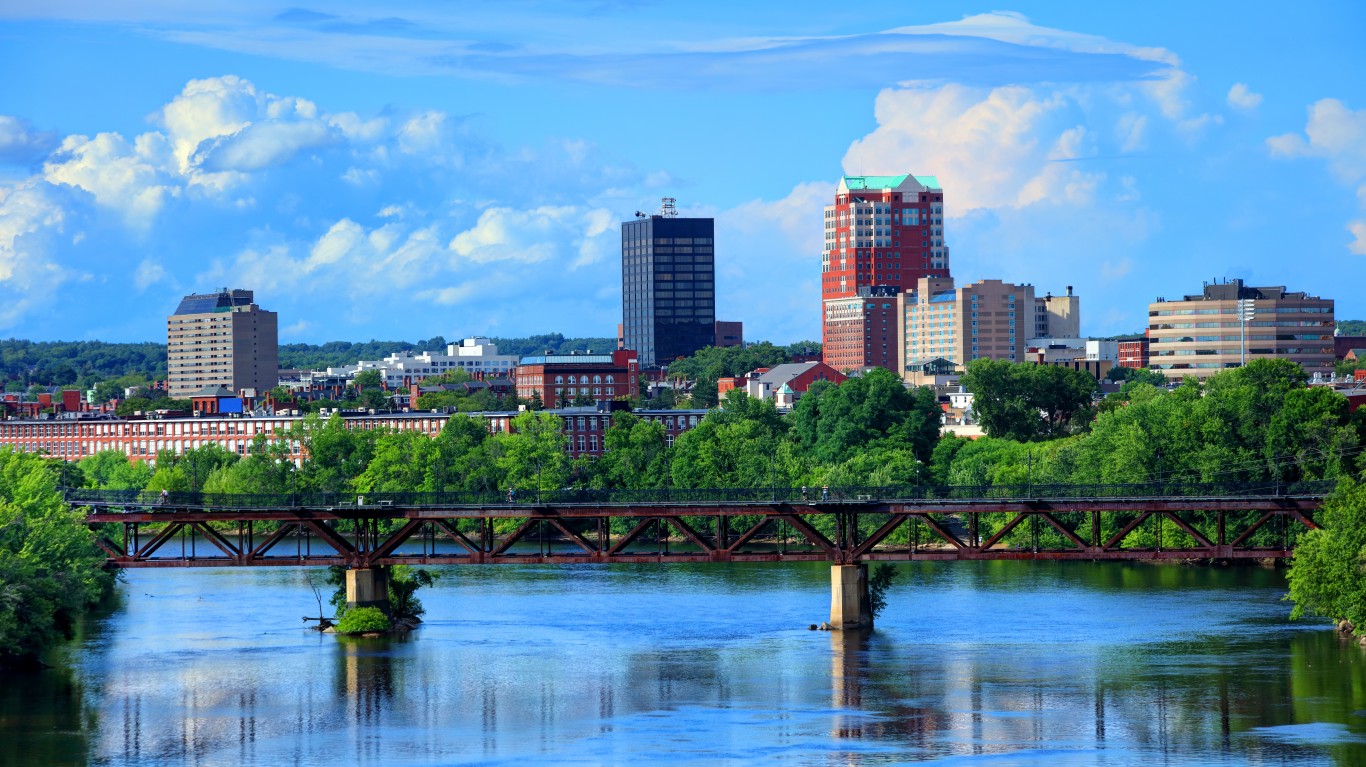
23. New Hampshire
> Workforce in high-risk industries: 15.1% of total (9th lowest)
> Unemployment claims since mid-March: 144,342 (18.8% of workforce — 9th highest)
> COVID cases as of April 27, 2020: 1,864 (13.7 per 10,000 people — 24th highest)
> COVID deaths as of April 27, 2020: 60 (0.4 per 10,000 people — 22nd lowest)
> Projected unemployment rate, July 2020: 15.0% (16th lowest)
New Hampshire’s unemployment rate as of March was one of the lowest in the country, at 2.6% compared to the national rate of 4.4%, but this could change soon in the wake of the pandemic. Over 144,000 New Hampshire workers have filed for unemployment since mid-March, equivalent to about 19% of the state’s workforce.
New Hampshire has the highest concentration of employment in retail trade, an industry with a medium level of vulnerability to the economic effects of COVID-19. The state’s substantial dairy industry has struggled as well thanks to the closure of schools and restaurants. Farmers across the state are being forced to dump gallons of milk to keep prices under control.
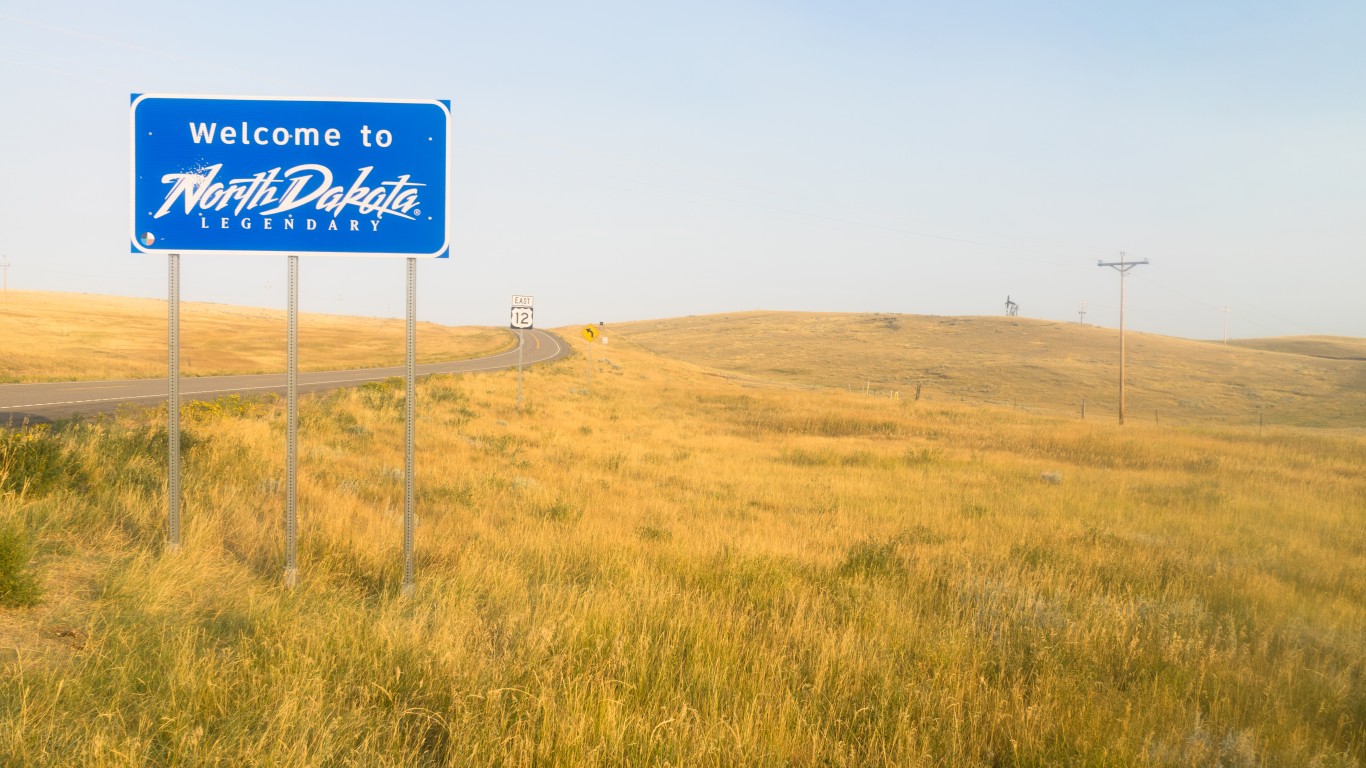
22. North Dakota
> Workforce in high-risk industries: 19.8% of total (8th highest)
> Unemployment claims since mid-March: 51,149 (12.8% of workforce — 23rd lowest)
> COVID cases as of April 27, 2020: 942 (12.4 per 10,000 people — 21st lowest)
> COVID deaths as of April 27, 2020: 19 (0.2 per 10,000 people — 11th lowest)
> Projected unemployment rate, July 2020: 15.6% (19th highest)
Oil and gas extraction is one of the industries expected to bear the brunt of the economic downturn — and North Dakota has the second highest share of workers in that industry of any state. Partially as a result, unemployment is projected to be worse in North Dakota than in most states in the coming months. In the lead up to the crisis, North Dakota had the best job market of any state with a March 2020 unemployment rate of just 2.2%. Now the EPI has projected the unemployment rate to climb to 15.6% by July, which is higher than the majority of other states.
[in-text-ad-2]
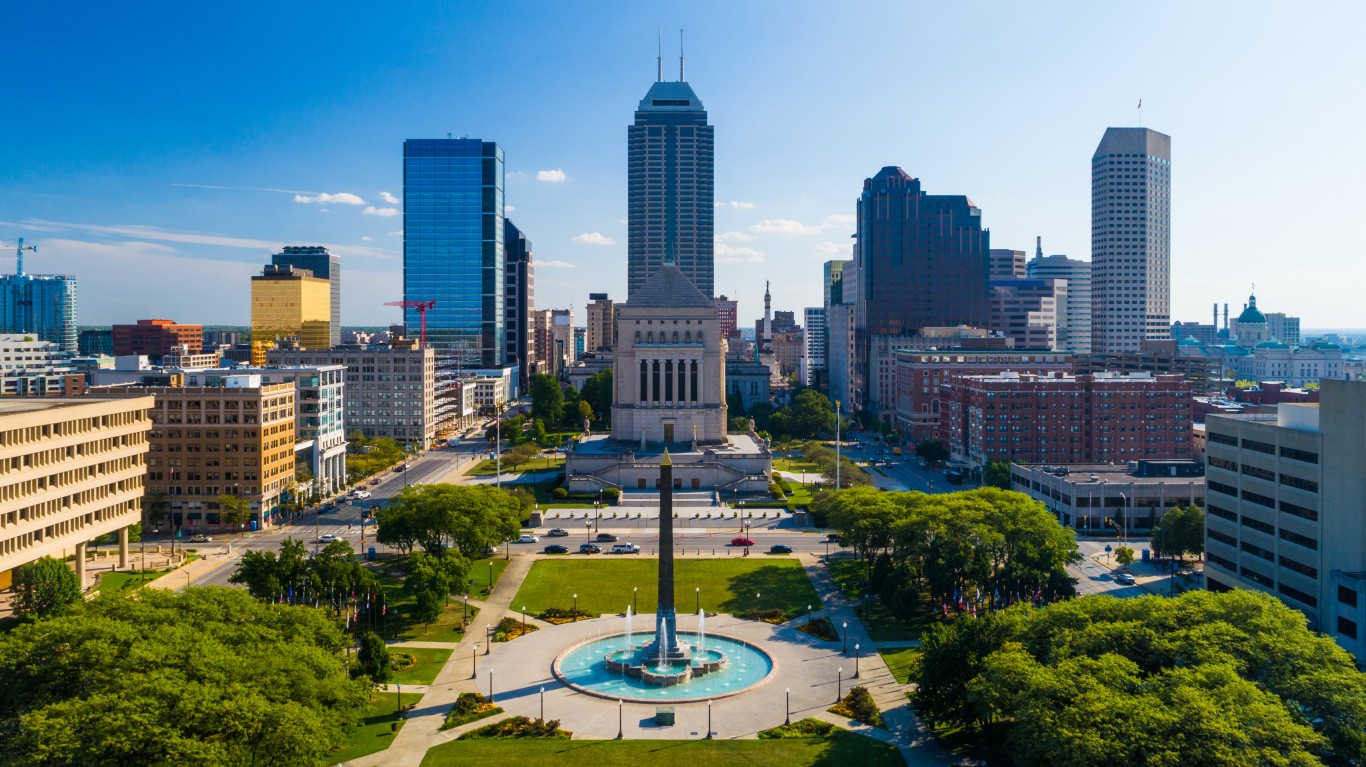
21. Indiana
> Workforce in high-risk industries: 18.0% of total (21st highest)
> Unemployment claims since mid-March: 515,177 (15.2% of workforce — 19th highest)
> COVID cases as of April 27, 2020: 15,961 (23.9 per 10,000 people — 12th highest)
> COVID deaths as of April 27, 2020: 844 (1.3 per 10,000 people — 10th highest)
> Projected unemployment rate, July 2020: 15.0% (16th lowest)
As of March 15, over half a million people in Indiana have filed for unemployment, or 15.2% of the workforce — a larger share than in most states. Indiana has effectively been shut down since March 23, and the stay-at-home order is set to expire on May 1. Whether the order would indeed expire remains to be seen as Gov. Eric Holcomb has remained tight-lipped on the issue.
Indiana is one of the nation’s leading pork producers, and two pork processing plants temporarily shut down in the state. The plants’ closure may lead to price increases and shortages elsewhere in the United States.

20. South Carolina
> Workforce in high-risk industries: 19.6% of total (10th highest)
> Unemployment claims since mid-March: 347,137 (14.7% of workforce — 23rd highest)
> COVID cases as of April 27, 2020: 5,490 (10.8 per 10,000 people — 16th lowest)
> COVID deaths as of April 27, 2020: 174 (0.3 per 10,000 people — 16th lowest)
> Projected unemployment rate, July 2020: 15.0% (16th lowest)
A relatively high 55.9% of employment in South Carolina is in industries that are either at medium or high levels of vulnerability to the negative economic effects of the pandemic and the measures implemented to control it. The state has a relatively large leisure and hospitality industry, which has been one of the hardest-hit industries during this crisis.
In late March, the South Carolina Small Business Chamber conducted a poll of its members, and 60% of respondents said that without a cash infusion, they would go out of business within three months. Nationwide, some small businesses have been able to access loans from the Small Business Administration, but others have not been able to secure funding.
[in-text-ad]
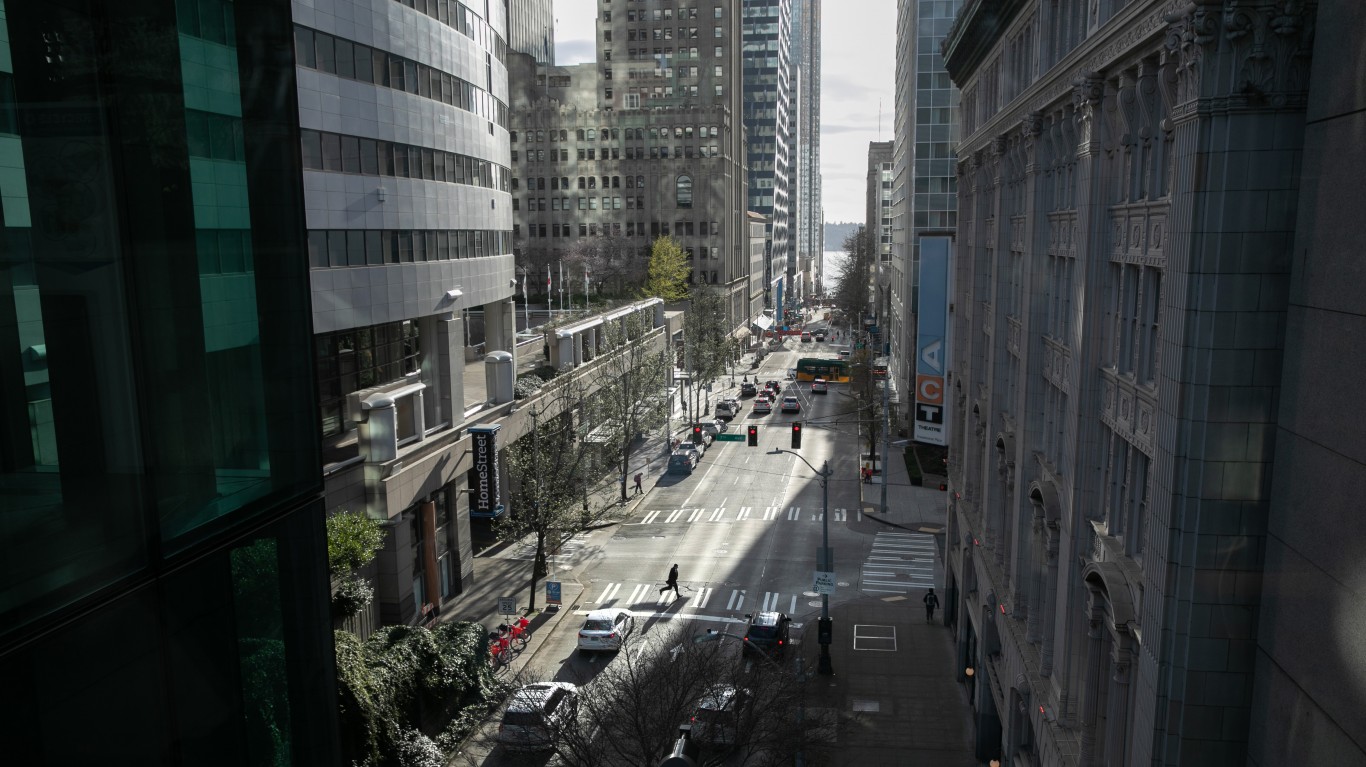
19. Washington
> Workforce in high-risk industries: 15.0% of total (5th lowest)
> Unemployment claims since mid-March: 717,570 (18.5% of workforce — 10th highest)
> COVID cases as of April 27, 2020: 13,521 (17.9 per 10,000 people — 18th highest)
> COVID deaths as of April 27, 2020: 749 (1.0 per 10,000 people — 14th highest)
> Projected unemployment rate, July 2020: 15.2% (21st lowest)
In Washington state, a staggering 18.5% of the workforce has filed for unemployment since March 15. Washington was one of the earliest hit states by COVID-19, and a stay-at-home order has been in place since March 23. Despite efforts to contain the spread of the virus, Washington has a higher infection count per capita than most other states. So far, there have been 13,521 confirmed cases of COVID-19 in Washington, or 17.9 for every 10,000 people, 18th highest among states but lower than the national figure of 29.4 per 10,000.

18. California
> Workforce in high-risk industries: 17.9% of total (22nd highest)
> Unemployment claims since mid-March: 3.4 million (17.3% of workforce — 13th highest)
> COVID cases as of April 27, 2020: 43,703 (11.0 per 10,000 people — 19th lowest)
> COVID deaths as of April 27, 2020: 1,720 (0.4 per 10,000 people — 21st lowest)
> Projected unemployment rate, July 2020: 15.6% (19th highest)
On March 19, 2020 California became the first state to impose a stay-at-home order. With a longer shutdown period than most states, California has also had higher than average unemployment claims. Between March 15 and April 18, some 3.4 million Californians applied for unemployment, or 17.3% of the state’s workforce — a larger share than in most other states. California is coordinating the reopening of nonessential businesses with nearby Oregon and Washington states.

17. Wyoming
> Workforce in high-risk industries: 25.5% of total (3rd highest)
> Unemployment claims since mid-March: 25,707 (8.9% of workforce — 3rd lowest)
> COVID cases as of April 27, 2020: 370 (6.4 per 10,000 people — 6th lowest)
> COVID deaths as of April 27, 2020: 7 (0.1 per 10,000 people — 3rd lowest)
> Projected unemployment rate, July 2020: 16.3% (10th highest)
Wyoming is one of the largest producers of coal, oil, and natural gas in the country, producing 15 times more energy than it consumes. As energy prices have plummeted, the state’s energy extraction companies have struggled. As of 2018, 7.6% of employment in the state was in mining, quarrying, and oil and gas extraction, the highest share of any state and well above the 0.5% national share. Despite this, the state’s new unemployment claims have been among the lowest of any state relative to the size of the labor force. The COVID-19 infection count per capita has also been relatively low. However, the EPI projects the state’s unemployment rate could rise to 16.3% by July, which would be the 10th highest among states.
[in-text-ad-2]
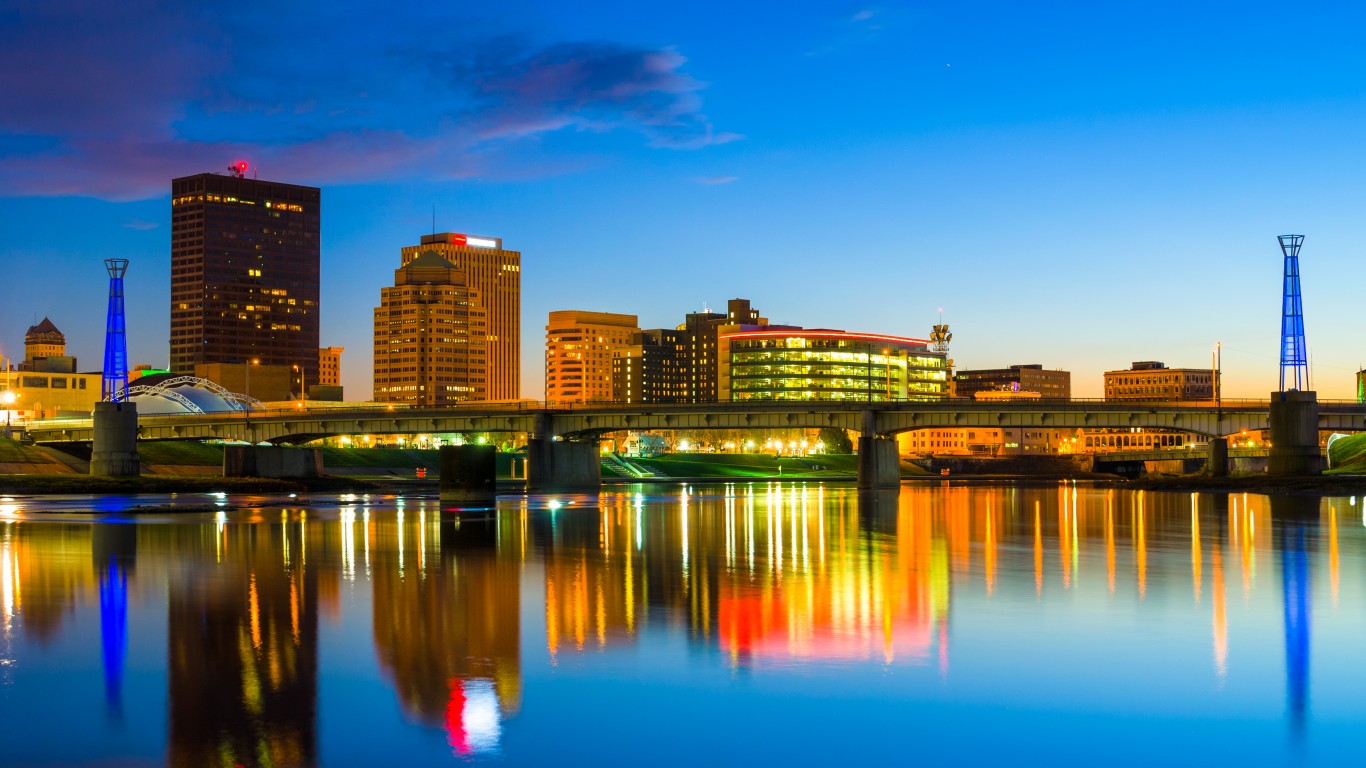
16. Ohio
> Workforce in high-risk industries: 17.0% of total (24th lowest)
> Unemployment claims since mid-March: 964,906 (16.7% of workforce — 15th highest)
> COVID cases as of April 27, 2020: 15,963 (13.7 per 10,000 people — 25th highest)
> COVID deaths as of April 27, 2020: 728 (0.6 per 10,000 people — 19th highest)
> Projected unemployment rate, July 2020: 16.4% (8th highest)
Almost 1 million Ohioans have filed for unemployment since mid-March, equal to a staggering 16.7% of the labor force. On April 28, Gov. Mike DeWine and his administration laid out plans to restart Ohio’s economy, including allowing a number of businesses in distribution, construction, and manufacturing businesses in the state to reopen. Ohio has one of the largest manufacturing workforces in the country.
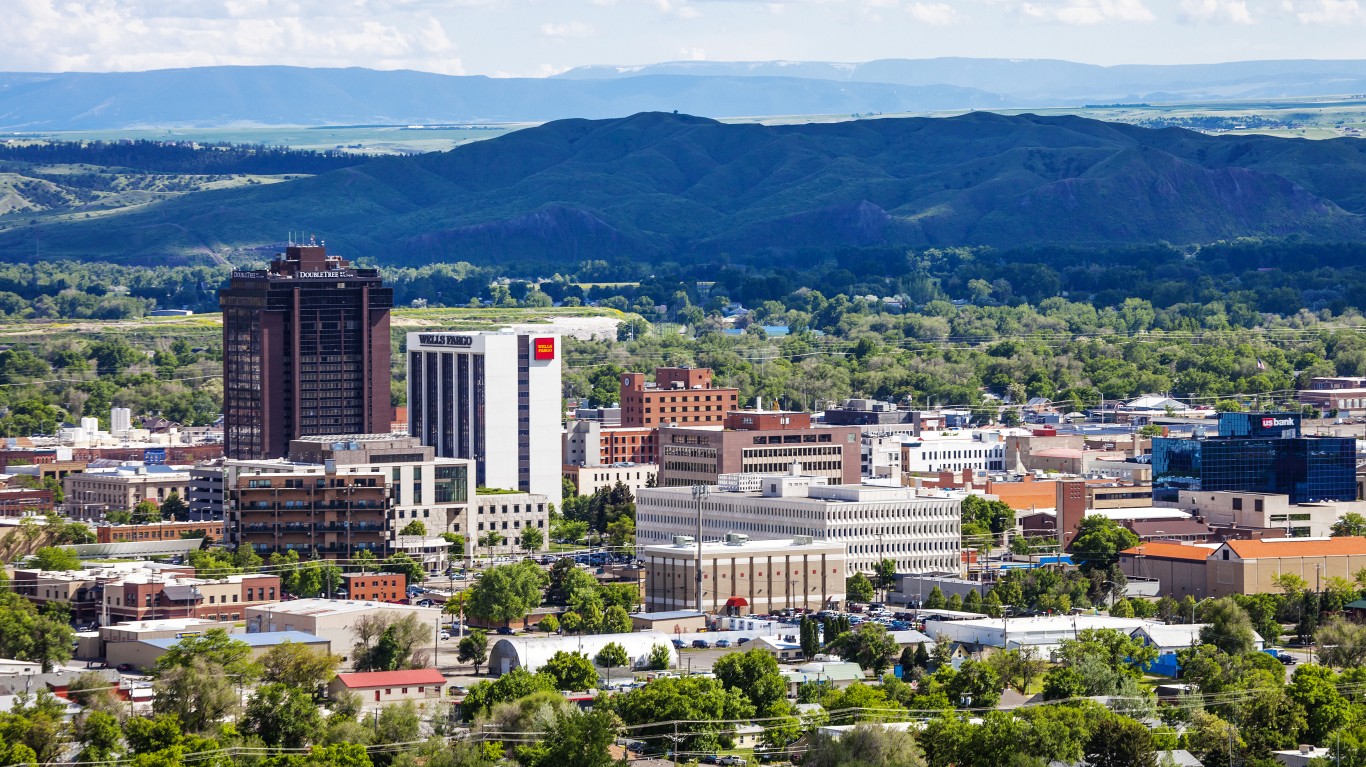
15. Montana
> Workforce in high-risk industries: 19.4% of total (14th highest)
> Unemployment claims since mid-March: 82,140 (15.6% of workforce — 17th highest)
> COVID cases as of April 27, 2020: 449 (4.2 per 10,000 people — the lowest)
> COVID deaths as of April 27, 2020: 14 (0.1 per 10,000 people — 6th lowest)
> Projected unemployment rate, July 2020: 16.3% (10th highest)
Montana to date has the lowest COVID-19 infection count per capita of any state, at just 4.2 cases per 10,000 people as of April 27. Despite this, the state economy will likely not be immune as the pandemic has affected the national and global economies in ways that will likely have a major impact on the state.
The state has a substantial energy sector, with the nation’s largest recoverable coal reserves. Montana also has a high level of employment in leisure and hospitality, another industry that has been especially hard-hit by the crisis. The EPI projects the state’s unemployment rate will reach 16.3% in July, tied with Wyoming and Kentucky for the 10th highest projected rate among states.
[in-text-ad]
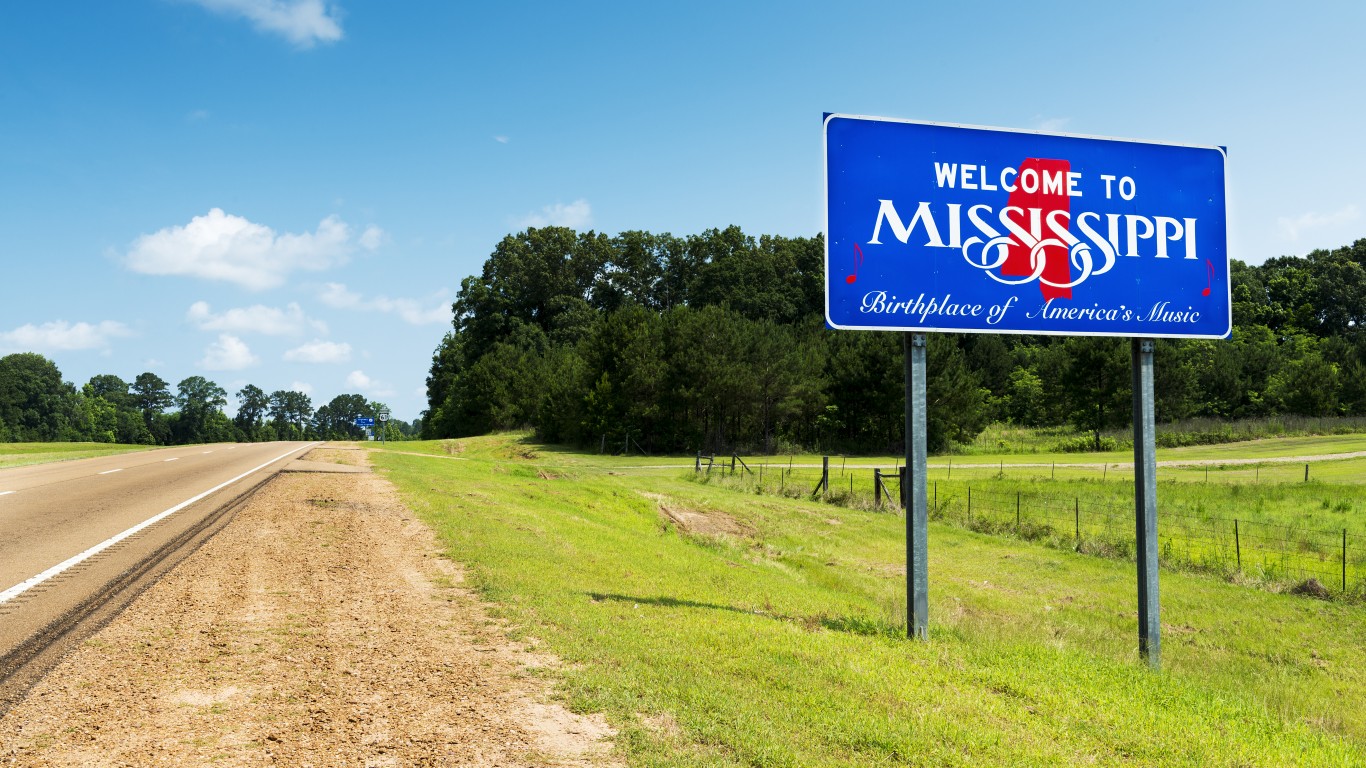
14. Mississippi
> Workforce in high-risk industries: 19.1% of total (16th highest)
> Unemployment claims since mid-March: 164,977 (13.0% of workforce — 25th lowest)
> COVID cases as of April 27, 2020: 6,094 (20.4 per 10,000 people — 16th highest)
> COVID deaths as of April 27, 2020: 229 (0.8 per 10,000 people — 16th highest)
> Projected unemployment rate, July 2020: 17.5% (5th highest)
Mississippi has an above average share of employment in highly at-risk industries, including leisure and hospitality and transportation and warehousing. In March, the state’s unemployment rate was 5.3%, already significantly higher than the national rate. The EPI estimates that by July, the state’s unemployment rate will reach 17.5%, the fifth highest projected unemployment rate of any state. On Monday, April 27, the state’s stay-at-home order expired, and some businesses in the state have begun reopening.

13. Massachusetts
> Workforce in high-risk industries: 15.0% of total (6th lowest)
> Unemployment claims since mid-March: 653,680 (17.2% of workforce — 14th highest)
> COVID cases as of April 27, 2020: 54,938 (79.6 per 10,000 people — 3rd highest)
> COVID deaths as of April 27, 2020: 2,899 (4.2 per 10,000 people — 4th highest)
> Projected unemployment rate, July 2020: 15.1% (18th lowest)
Massachusetts has a relatively low share of workers in high-risk industries, at 15.0% of employment. However, the state economy faces the risk of one of the worst coronavirus infection counts per capita of any state, at just about 80 per 10,000 residents. That figure is well more than double the national figure of 29.4 per 10,000, and is higher than any state other than New York or New Jersey. Massachusetts instituted a statewide stay-at-home order on March 24. On April 28, Gov. Charlie Baker announced plans to extend the state’s order through May 18.
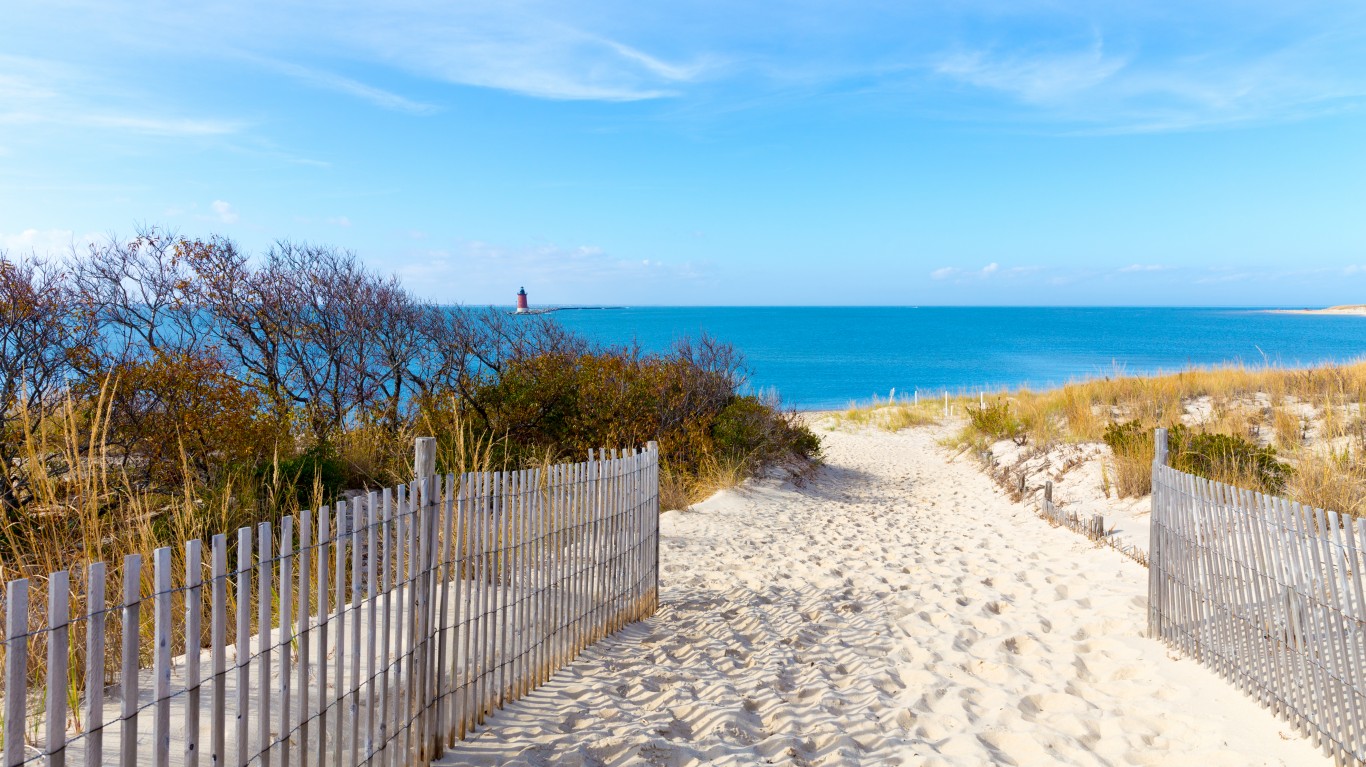
12. Delaware
> Workforce in high-risk industries: 17.0% of total (22nd lowest)
> Unemployment claims since mid-March: 71,316 (14.8% of workforce — 22nd highest)
> COVID cases as of April 27, 2020: 4,162 (43.0 per 10,000 people — 7th highest)
> COVID deaths as of April 27, 2020: 125 (1.3 per 10,000 people — 9th highest)
> Projected unemployment rate, July 2020: 16.8% (6th highest)
Like other similarly densely-populated states, Delaware has a higher concentration of confirmed cases of COVID-19 than much of the rest of the country. There were 43.0 cases for every 10,000 people as of April 27, more than in all but half a dozen other states. According to projections from the EPI, Delaware is facing a worse unemployment crisis than most states. By July, the state’s jobless rate could be as high at 16.8%, higher than the projected rates in all but five other states.
[in-text-ad-2]

11. Georgia
> Workforce in high-risk industries: 19.7% of total (9th highest)
> Unemployment claims since mid-March: 1.1 million (21.5% of workforce — 7th highest)
> COVID cases as of April 27, 2020: 23,773 (22.6 per 10,000 people — 15th highest)
> COVID deaths as of April 27, 2020: 942 (0.9 per 10,000 people — 15th highest)
> Projected unemployment rate, July 2020: 14.9% (11th lowest)
Nearly one in every five workers in Georgia are employed in industries expected to bear the brunt of the economic decline brought on by COVID-19 and the measures taken to contain the disease’s spread. Since March 15, over a million state residents have filed for unemployment, equal to 21.5% of the workforce — a larger share than in all but six other states.
In order to reduce the economic damage, Georgia is one of only a handful of states to have lifted some restrictions on certain businesses and is now allowing limited dining in at restaurants.

10. Michigan
> Workforce in high-risk industries: 16.4% of total (17th lowest)
> Unemployment claims since mid-March: 1.2 million (23.9% of workforce — 4th highest)
> COVID cases as of April 27, 2020: 37,778 (37.8 per 10,000 people — 8th highest)
> COVID deaths as of April 27, 2020: 3,315 (3.3 per 10,000 people — 6th highest)
> Projected unemployment rate, July 2020: 15.2% (21st lowest)
In Michigan, 1.2 million people have filed for unemployment since mid-March. That’s nearly 24% of the state’s total workforce, a larger share than in all but four other states. Michigan — particularly the city of Detroit — have been hit especially hard by the coronavirus. As of April 27, the statewide infection count per capita was 37.8 cases per 10,000, the eighth highest among states.
[in-text-ad]

9. New York
> Workforce in high-risk industries: 15.1% of total (7th lowest)
> Unemployment claims since mid-March: 1.4 million (14.6% of workforce — 24th highest)
> COVID cases as of April 27, 2020: 288,045 (147.4 per 10,000 people — the highest)
> COVID deaths as of April 27, 2020: 16,966 (8.7 per 10,000 people — the highest)
> Projected unemployment rate, July 2020: 16.4% (8th highest)
While workers in nearly all industries have been affected by the economic fallout from the COVID-19 pandemic, in some industries workers have been hurt more than others. In New York, 56% of employment is in industries deemed low risk by Moody’s, including financial activities, information, and health care.
However, New York has also been by far the hardest hit state by COVID-19 in the country, with 147.4 reported cases per 10,000 people, the highest of any state and five times the national rate of 29.4 cases per 10,000. The state’s stay-at-home order is set to remain in effect through at least the end of May.

8. Alaska
> Workforce in high-risk industries: 21.8% of total (4th highest)
> Unemployment claims since mid-March: 61,245 (17.7% of workforce — 12th highest)
> COVID cases as of April 27, 2020: 341 (4.6 per 10,000 people — 3rd lowest)
> COVID deaths as of April 27, 2020: 9 (0.1 per 10,000 people — 4th lowest)
> Projected unemployment rate, July 2020: 17.8% (3rd highest)
Due in large part to Alaska’s substantial oil and gas industry, more than one in every five workers in the state are employed in sectors that are most likely to face a slowdown in the wake of the COVID-19 pandemic. Partially as a result, the unemployment problem is projected to be far worse in Alaska in the coming months than in much of the rest of the country. According to EPI projections, an estimated 17.8% of workers in Alaska will be unemployed by July, well above the anticipated 15.6% U.S. unemployment rate that month.
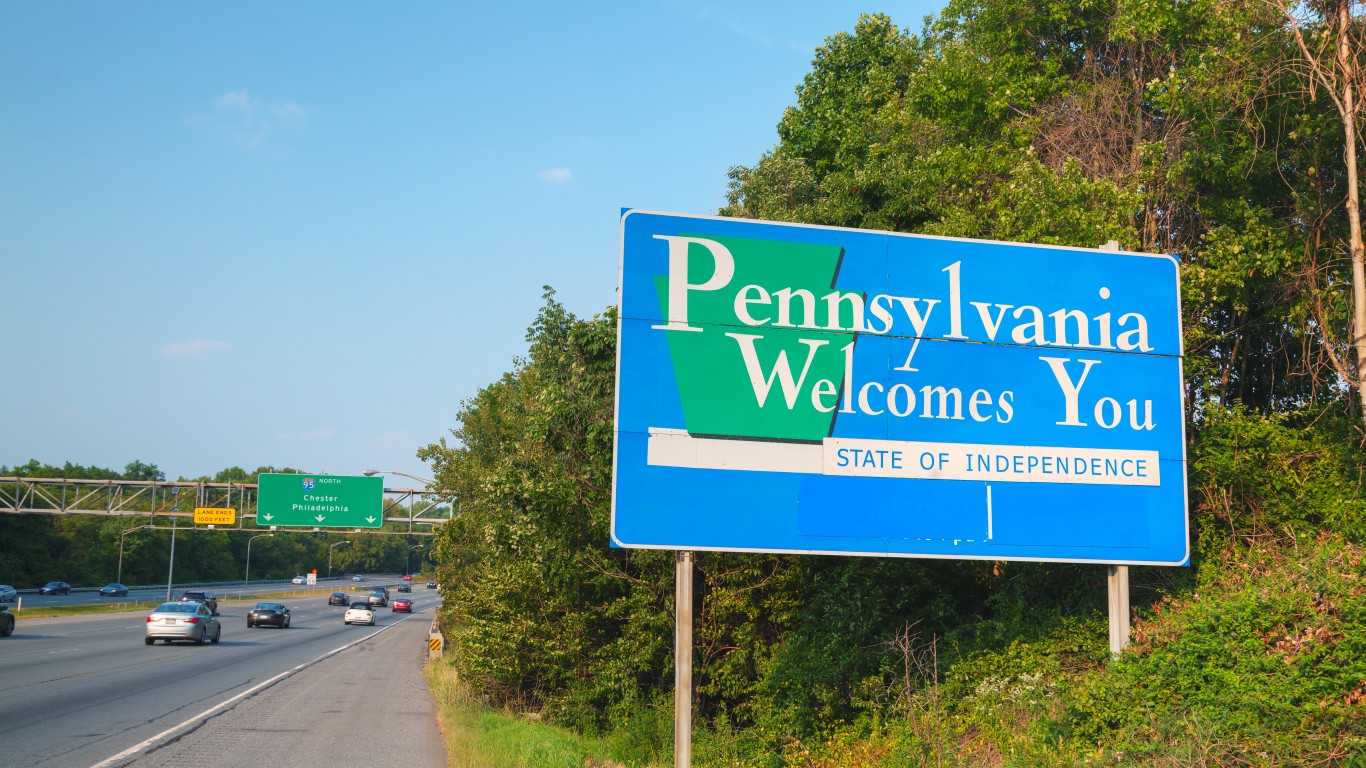
7. Pennsylvania
> Workforce in high-risk industries: 16.7% of total (20th lowest)
> Unemployment claims since mid-March: 1.5 million (23.2% of workforce — 5th highest)
> COVID cases as of April 27, 2020: 42,050 (32.8 per 10,000 people — 10th highest)
> COVID deaths as of April 27, 2020: 1,597 (1.2 per 10,000 people — 11th highest)
> Projected unemployment rate, July 2020: 16.6% (7th highest)
In Pennsylvania, a staggering 1.5 million workers have filed for unemployment since mid-March, the largest single total for any state other than California. Those newly unemployed Pennsylvanians comprise 23.2% of the state’s labor force. The state’s March unemployment rate of 6.0% was the fourth highest of any state. The EPI estimates the state will have an unemployment rate of 16.6% by July. Pennsylvania’s stay-at-home order as of the time of this writing was set to expire on May 8, and Gov. Tom Wolf has opted to permit residents to engage in limited outdoor activities.
[in-text-ad-2]
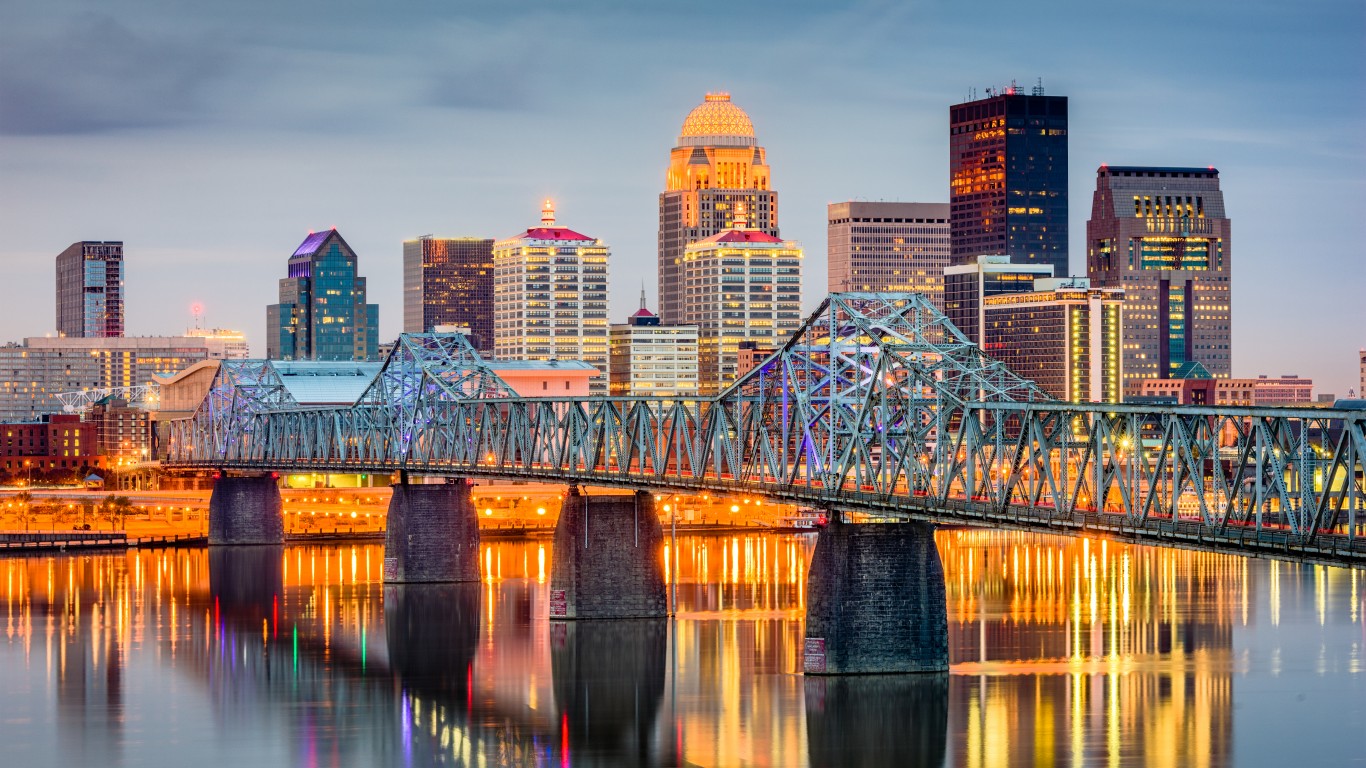
6. Kentucky
> Workforce in high-risk industries: 19.4% of total (13th highest)
> Unemployment claims since mid-March: 499,572 (24.3% of workforce — 2nd highest)
> COVID cases as of April 27, 2020: 4,074 (9.1 per 10,000 people — 13th lowest)
> COVID deaths as of April 27, 2020: 208 (0.5 per 10,000 people — 25th lowest)
> Projected unemployment rate, July 2020: 16.3% (10th highest)
Kentucky has one of the highest shares of state employment in industries most vulnerable to the economic effects of the pandemic, including transportation and warehousing. The state has the second highest share among states of employment in the sector. The state’s roughly 500,000 new unemployment claims since mid-March constitute nearly one-quarter of the state’s total workforce, the second highest share of any U.S. state.
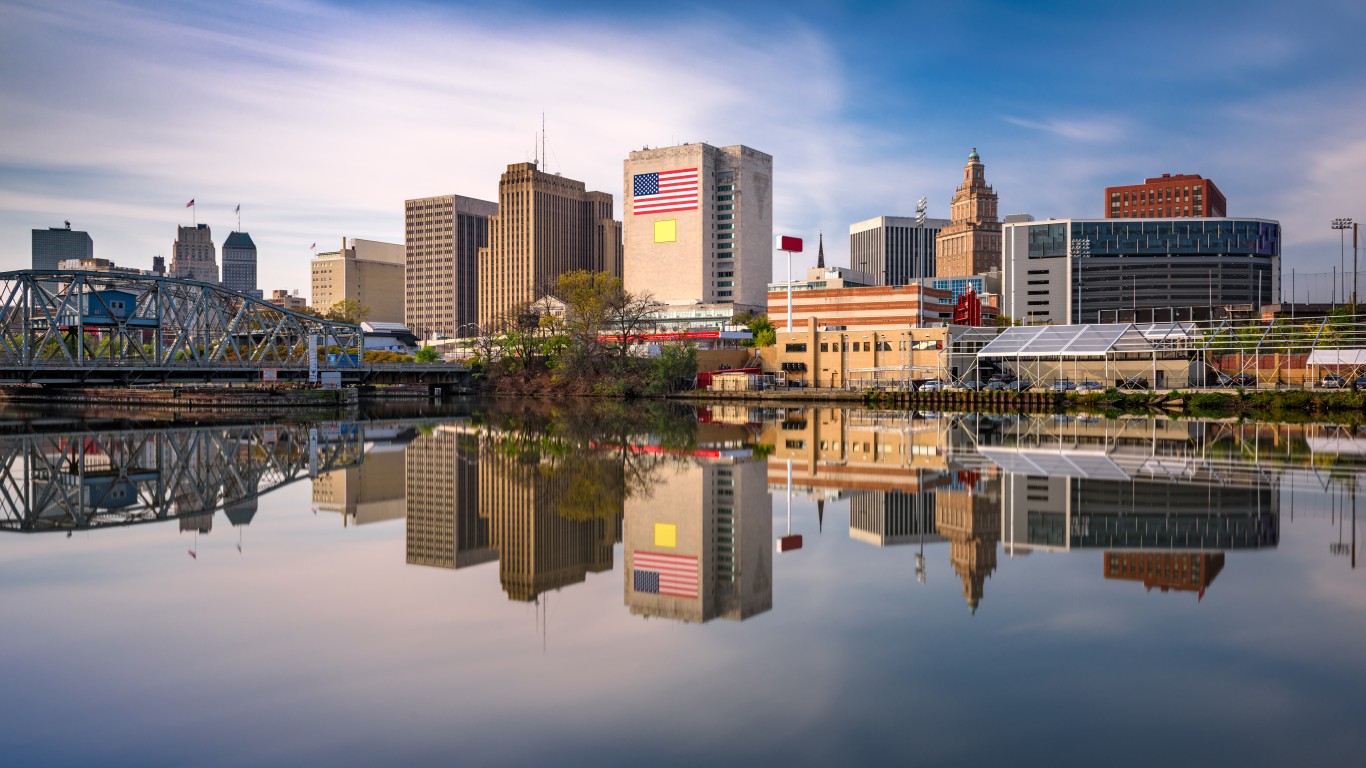
5. New Jersey
> Workforce in high-risk industries: 17.4% of total (24th highest)
> Unemployment claims since mid-March: 817,601 (18.3% of workforce — 11th highest)
> COVID cases as of April 27, 2020: 111,188 (124.8 per 10,000 people — 2nd highest)
> COVID deaths as of April 27, 2020: 6,044 (6.8 per 10,000 people — 2nd highest)
> Projected unemployment rate, July 2020: 15.6% (19th highest)
New Jersey has relatively high concentrations of workers in industries less vulnerable to the economic fallout from the pandemic. — the state has among the highest concentrations of employment in health care as well as professional and business services occupations.
However, New Jersey is second only to neighboring New York state in the severity of the coronavirus outbreak. As of April 27, the state had over 111,000 cases, or 124.8 cases per 10,000 people, more than four times the nation’s 29.4 cases per 10,000 people.
[in-text-ad]

4. Rhode Island
> Workforce in high-risk industries: 17.1% of total (25th highest)
> Unemployment claims since mid-March: 131,977 (23.9% of workforce — 3rd highest)
> COVID cases as of April 27, 2020: 7,708 (72.9 per 10,000 people — 4th highest)
> COVID deaths as of April 27, 2020: 233 (2.2 per 10,000 people — 7th highest)
> Projected unemployment rate, July 2020: 15.4% (24th lowest)
Like many other densely-populated states in the Northeast, Rhode Island has been hit especially hard by COVID-19, with over 72.9 reported cases per 10,000 residents as of April 27, compared to the national figure of 29.4 per 10,000. Since the middle of March, more than 130,000 state workers have filed for unemployment, equivalent to 23.9% of the state’s labor force — the third highest share of any state. The state labor department issued a statement on April 29 saying the pandemic will result in $1.1 billion in lost wages for state workers through the second quarter of 2020.

3. Louisiana
> Workforce in high-risk industries: 19.5% of total (12th highest)
> Unemployment claims since mid-March: 442,151 (21.3% of workforce — 8th highest)
> COVID cases as of April 27, 2020: 27,068 (58.1 per 10,000 people — 6th highest)
> COVID deaths as of April 27, 2020: 1,697 (3.6 per 10,000 people — 5th highest)
> Projected unemployment rate, July 2020: 18.0% (2nd highest)
Louisiana has been the hardest-hit state in the South from COVID-19, with 58.1 confirmed cases per 10,000 As of April 28, the sixth highest. Louisiana had the highest state unemployment rate in the country in March, at 6.9%. That will likely soon be much higher, as hundreds of thousands of state workers have lost their jobs in the past month. The EPI projects that the state’s unemployment rate could reach 18.0% by July, the second highest projection of any state.

2. Hawaii
> Workforce in high-risk industries: 27.1% of total (2nd highest)
> Unemployment claims since mid-March: 171,708 (25.8% of workforce — the highest)
> COVID cases as of April 27, 2020: 606 (4.3 per 10,000 people — 2nd lowest)
> COVID deaths as of April 27, 2020: 14 (0.1 per 10,000 people — the lowest)
> Projected unemployment rate, July 2020: 17.8% (3rd highest)
COVID-19 infections have been relatively uncommon in Hawaii — the state had the second fewest reported cases per capita of any state as of April 27, at 4.3 per 100,000, compared to the national figure of 29.4 per 10,000.
However, the relatively low number of cases has not stopped the pandemic from decimating the state economy. Since mid-March, over 170,000 Hawaiians have filed for unemployment, equivalent to a nation-worst 25.8% of the state’s labor force. Hawaii’s economy is especially concentrated in industries like travel and leisure and hospitality, two industries that have been especially hard-hit during the crisis.
[in-text-ad-2]

1. Nevada
> Workforce in high-risk industries: 33.5% of total (the highest)
> Unemployment claims since mid-March: 343,075 (22.4% of workforce — 6th highest)
> COVID cases as of April 27, 2020: 4,639 (15.3 per 10,000 people — 20th highest)
> COVID deaths as of April 27, 2020: 206 (0.7 per 10,000 people — 18th highest)
> Projected unemployment rate, July 2020: 19.7% (the highest)
Over one-third of Nevada’s employment is in industries that are at the highest levels of risk from the economic effects of the pandemic. This is about double the national concentration of employment in these industries. The EPI estimates that Nevada will have close to a 20% unemployment rate by July, and that figure could be even higher, as already 25.8% of the state’s labor force has filed for unemployment.
On March 17, Gov. Steve Sisolak ordered all casinos in the state to cease operations. The state’s gaming revenue dropped 40% in March and could drop even more in April as casinos in the state will have been closed for over a month.
Methodology
To determine the states most likely to be hurt by COVID-19, 24/7 Wall St. created a weighted index of four measures. The first measure, which comprises 30% of the index, is the share of total employment in industries deemed to be at high-risk of slowdown due to the coronavirus outbreak. The second measure, which comprises 20% of the index, is the number of diagnosed cases per capita as of April 27 2020. The third measure, which comprises 30% of the index, is the number of new unemployment claims made since the week ending March 21 as a share of the 2018 state labor force, from the U.S. Bureau of Labor Statistics. The fourth measure, which comprises 20% of the index, is the projected unemployment rate by state for July 2020 from a report published on April 1 by the Economic Policy Institute, a nonpartisan, nonprofit think tank.
The identification of high-risk industries comes from the March 2020 paper “COVID-19: A Fiscal Stimulus Plan” published by Moody’s Analytics, an economics research firm.
Data on COVID-19 cases and deaths by state came from various state and local health departments and are current as of April 27 2020. COVID-19 cases and death toll were adjusted for population using five-year estimates from the U.S. Census Bureau’s 2018 American Community Survey. Population density was calculated using 2010 land area estimates from the Census Bureau and one-year population estimates from the 2018 ACS.
Retirement planning doesn’t have to feel overwhelming. The key is finding expert guidance—and SmartAsset’s simple quiz makes it easier than ever for you to connect with a vetted financial advisor.
Here’s how it works:
Why wait? Start building the retirement you’ve always dreamed of. Click here to get started today!
Thank you for reading! Have some feedback for us?
Contact the 24/7 Wall St. editorial team.